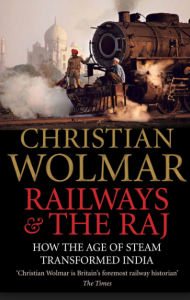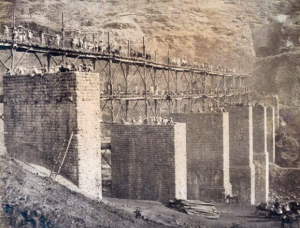
India’s flourishing Railways and the Raj – Wolmar



68-year-old Christian Wolmar, a London based railway historian and an award-winning writer and broadcaster specialising in transport, examines the complicated legacy of the Indian Railways, including the brutal history.
His research which took him over a year, travelling the length and breadth of India on trains, culminated with a lecture on Indian Railway history at the Oxford Literary Society. In his latest book Railways and the Raj ( Atlantic Books), he reveals “ There are too many shocking stories that need to be shared, including the myth that the British gave India its first ever transport system. The fundamental questions that we need to ask are why the British built the railways, to what extent it was really helpful for India and how much was done for Britain’s own benefit. The intent was definitely not altruistic. We built the railways because they enabled us to export raw materials and import manufactured goods, and by the by, it also gave India a fantastic transport system”. “ I read railway history and then re-write leaving out the boring bits”. His chief concern was to boost the Indian- and therefore the British – economy by establishing lines running inland from the major ports of Mumbai, Calcutta and Madras. But since “ his relentless expansion of British control over India necessitated the occasional war, Lord Dalhousie, the then Governor General of India, did not omit the military imperative.” Much of the early railway would be sent over by mail order from Britain: flat-packed waiting rooms, “ Meccano” bridges and fully assembled locomotives. At first, the railway caused a cultural shock to ordinary Indians.
After the mutiny of 1857, railways became, even more, an instrument of control. In 1902, Indian Railways were operated by 33 separate administration, including 24 private companies, four government agencies and five princely states. For the nationalists, the railways represented imperialism on wheels. Any Indians who boarded the trains were usually locked into third-class compartments, occupying seats 14 inches wide and also used unfenced tracks as footpaths.
The growth and financial success of the railways in the 1930s were punctuated by the nationalist sabotage, which intensified during the second world war. One simple way of sabotage was to pull the communication cord, so stopping the train. After the war, much of the violence of partition was focused on the railways, with the “ corpse trans” arriving at their destinations having crossed the new border with a payload of dismembered passengers.
The task of building India’s complex railway network was merely an exercise in the interest of the Empire, including the Bhor Ghat project on the Western Ghats one of the most perilous project due to the ever-present danger of falling rocks slips and cave-ins which costs 25, 000 lives, due to illness and disease, and exposing the appalling conditions in which Indians worked. When the Bhor Ghat project was completed, Sir Bartle Frere, the then Governor of Bombay, “lauded the work of the English engineers, conveniently forgetting that it was Indian labour that had created this almost miraculous railway”.
“The Railways could have easily been something that the British did with the Indians, and therefore, worked to both help India and its people. Instead the British built the railways with their companies that profited from it. They didn’t even treat Indians as equals, and it’s very telling that they didn’t allow them to drive the trains, and wouldn’t let them be station masters or run the services. That’s just ridiculous given that India would eventually take over the Railway’s post Independence. Fortunately, they got the railways going very quickly and efficiently, and built more networks” Wolmar adds.
“Indian Railway today boasts of an impressive network, yes, it does need more investment, but the fact that the railways still continues to be absolutely vital to India and its people is what is most fascinating” Wolmar’s final analysis.
Railways and the Raj: How the Age of Steam Transformed India, by Christian Wolmar, Atlantic Books, RRP £25, 384 pages.
